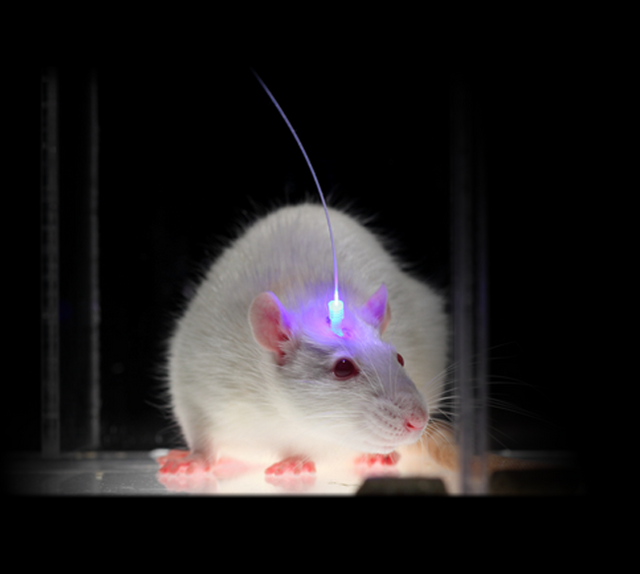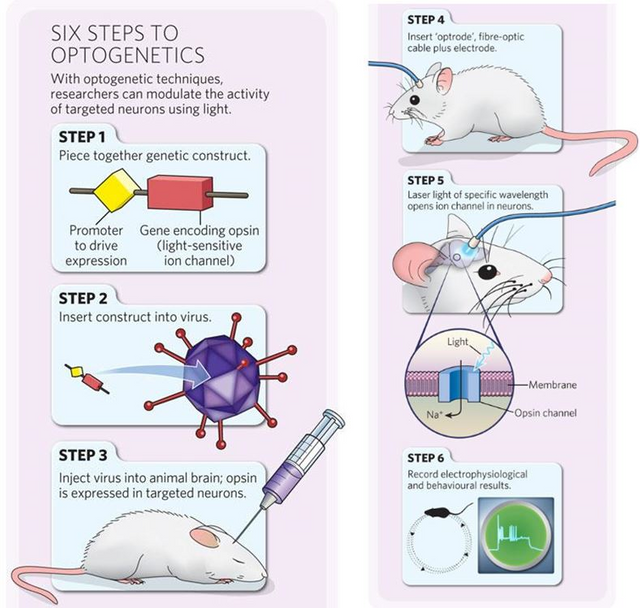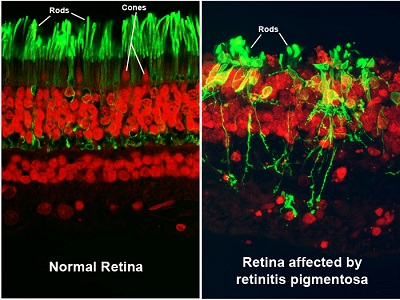Steps towards optogenetics: (not) Light Sticks
Optogenetics (from Greek optikós, meaning 'seen, visible') is a biological technique that involves the use of light to control cells in living tissue, typically neurons, that have been genetically modified to express light-sensitive ion channels. It is a neuromodulation method that uses a combination of techniques from optics and genetics to control and monitor the activities of individual neurons in living tissue—even within freely-moving animals—and to precisely measure these manipulation effects in real-time. Optogenetics wikipedia source
I explained this optogenetic method on this occasion how the method developed by Karl Deisseroth and Ed Boyden. Deisseroth is a neuroscientist (neurology or neuroscientist) at Stanford University, while Ed Boyden is Deisseroth's protégé when they both developed the method.
The history of optogenetics actually began decades ago. Forty years before Deisseroth and his team discovered this method, microbiologists have learned that some microorganisms can produce proteins that can be activated by visible light. The protein is able to regulate the flow of ions through the plasma membrane in cells directly.
On the other hand, neuroscience also understands that to activate nerve and muscle cells, certain ions flow through the plasma membrane. However, do they realize the possibility of connecting these two fields of microbiology and neuroscience?
In the above question, of course the answer is yes. Unfortunately, too many scientists are skeptical of the success of "marriage" in two very contradictory fields, certainly with many considerations that are not arbitrary.
Decades later, with high motivation, in-depth knowledge, and highly talented team members, the bioengineering team led by Deisseroth tried hard to realize the challenge of "microbial protein + nerve cells". This high-risk study eventually produced sweet results.
The Deisseroth team managed to isolate DNA which encodes the ability to capture and utilize light (photoreceptive) from algae and move the gene into mouse nerve cells. Furthermore, opsin, a protein that can convert light into electrical signals, is also produced from these genes. When opsin is exposed to certain light, opsin will cause excited neurons. Fvoila! This is what has long been awaited by neuroscientists.
Steps towards optogenetics
How do researchers do it? First, the researchers isolated DNA which encodes the photoreceptive ability and forms gene construction first. This gene construction consists of a promoter (to encourage gene expression) and a gene that encodes opsin (a light-sensitive protein).
Using tricks from the field of gene therapy, we can put these molecules into brain cells (also called neurons). The brain is a massive network of neurons that communicate using electricity. What we’re doing is putting molecules that convert light into electricity into brain cells. Then we shine the light on the neurons, and light gets converted to electricity so we can turn brain cells on or off. In this way we can achieve our goal of controlling activity in some brain cells but not others. The majority of usage for optogenetics is in the area of research like this but there are some startups that are already trying to commercialize it. Nanalyze source
After successful construction of the gene, the construction is then inserted into the body of the virus to be injected into the rat's brain. In mouse nerve cells, these genes produce opsin. The fourth step, ‘optrode’ aka a combination of fiber optic cable plus an electrode connected to the rat's brain.
Finally, after all devices are installed, nerve cells are given light exposure with a certain wavelength. The light causes ion channels in nerve cells and allows the entry of sodium ions. Cells are finally excited (delivering signals).
The main role
Friends of steemians are you curious about the main role of this optogenetic technology? Let's introduce, here there is already channelrhodopsin derived from green algae, halorhodopsin from archaea and bacteriorhodopsin from bacteria. They are all opsin groups, photoreceptive proteins that originate from algae and bacteria.
Proteins of different types can be stimulated with different light. Channelrhodopsin is stimulated with blue light to excite cells while halorhodopsin is stimulated with yellow light to deactivate cells.
Each of these proteins is activated by a different light and gives different effects as well as excitation or inhibition. Channelrhodopsin can be activated with blue light and causes cells to be excited. Halorhodopsin and bacteriorhodopsin are activated by different light, yellow and green, but produce the same effect, inhibition (inactive cells).
How about cells that are on and off?
When the nerve or muscle cells are excited, we call the state as on or propagate the signal. Meanwhile, when the signal delivery is inhibited (inhibition), the cell is in an off state so that the cell does not function.
In research on brain function, making certain cells in an on or off state becomes very important. Why? Because by turning on the cell researchers can see what functions are initiated or supported by the cell. On the other hand, when the cell is off or loses its function, by observing the behavior or function that is missing from the target we can understand the important function of the cell.
What is great?
The Optogenetics developed by Deisseroth and Boyden received the "Method of the Year" award from the journal Nature Optogenetic was also hailed and predicted to bring major changes to the world of neuroscience, especially its application to research on diseases and health. Well, what's the great thing?
The Optogenetics developed by Deisseroth and Boyden received the "Method of the Year" award from the journal Nature Optogenetic was also hailed and predicted to bring major changes to the world of neuroscience, especially its application to research on diseases and health. Do you know friends, that by using optogenetics scientists can deliver optical controls with high precision (specific to certain cell types as desired) and high speed (millisecond scale). Try to compare it with the use of complicated electrodes - stimulate all cells in the circuit without differentiating the cell type - or the non-specific and slow delivery of drugs. With these advantages, researchers can easily observe complex systems such as brain in moving mammals. Retinitis pigmentosa source
Do you know friends, that by using optogenetics scientists can deliver optical controls with high precision (specific to certain cell types as desired) and high speed (millisecond scale). Try to compare it with the use of complicated electrodes - stimulate all cells in the circuit without differentiating the cell type - or the non-specific and slow delivery of drugs. With these advantages, researchers can easily observe complex systems such as brain in moving mammals.
The power of light in the future
As scientists have demonstrated, microbial surgery can be tolerated by living mammalian brains without significant interference. Therefore, many optogenetic studies are focused on neurological diseases. This is a promising potential for the treatment of neurological diseases.
Epilepsy
Scientists predict, in the future optogenetics can be used to cure epilepsy (epilepsy). Neuron cells that are damaged and cause seizures can be "silenced" and controlled by an opsin. So far, experiments have been carried out on rodents and are being tested in primates.
Bring back the vision (restore the vision)
Retinal degeneration inherited from parents (inherited retinal degeneration) which causes total or partial blindness affects 1 in 3000 people worldwide. Although drug therapy is available for age-related degenerative diseases, none has been proven to be able to treat genetically caused diseases such as retinitis pigmentosa.
Comparison of normal (left) and retinal retina damaged by retinitis pigmentosa (right).
Until now there is no treatment that can restore vision if the cone cells and stem cells in the retina are damaged. With optogenetics, scientists want to manipulate ganglion cells in the retina so that they can be sensitive to light, replacing the function of cone cells and damaged rods.
Retinitis pigmentosa is a term used to describe a group of eye diseases that damage the retina. The retina is the layer of tissue located in the back of the inner eye that converts light images to nerve signals and transmits them to the brain. Eye health source
In addition to those already mentioned above, optogenetics is also predicted to be applicable to many other things such as gene therapy, brain function mapping, cell culture, neural network analysis, to Parkinson's treatment. Well, friends can see if the "sticks of light" are now no longer a fantasy typical of a fairy tale world.
God has given us the ability to think, think of His creation in the universe to be studied and utilized. With high motivation and an unyielding spirit some fantasy in a fairy tale world will probably come true. One of them is the optogenetic (not) light stick.




Thanks for using eSteem!
Your post has been voted as a part of eSteem encouragement program. Keep up the good work! Install Android, iOS Mobile app or Windows, Mac, Linux Surfer app, if you haven't already!
Learn more: https://esteem.app
Join our discord: https://discord.gg/8eHupPq
Congratulations! Your post has been selected as a daily Steemit truffle! It is listed on rank 22 of all contributions awarded today. You can find the TOP DAILY TRUFFLE PICKS HERE.
I upvoted your contribution because to my mind your post is at least 7 SBD worth and should receive 125 votes. It's now up to the lovely Steemit community to make this come true.
I am
TrufflePig, an Artificial Intelligence Bot that helps minnows and content curators using Machine Learning. If you are curious how I select content, you can find an explanation here!Have a nice day and sincerely yours,

TrufflePig